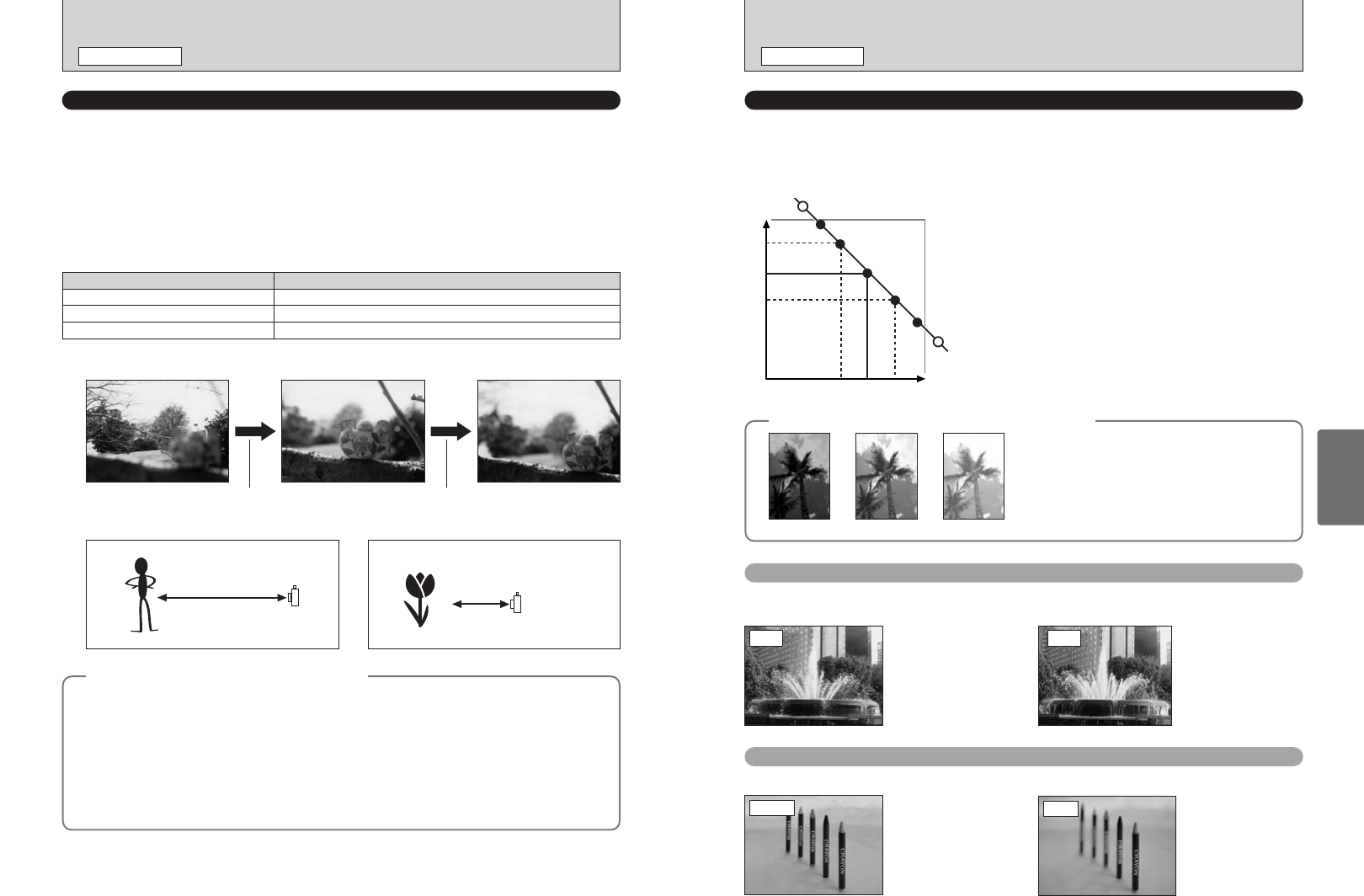
35
Advanced
Features
34
EXPOSURE
(
SHUTTER SPEED AND APERTURE
)
STILL IMAGE MODE
EXPOSURE
Exposure refers to the light that hits the CCD or the total amount of captured light and determines
the brightness of the image.
The exposure is determined by the combination of aperture and shutter speed. In AE (automatic
exposure), the camera automatically determines the correct exposure, allowing for factors such as
the brightness of the subject and the ISO setting.
The graph at left shows the way the aperture and shutter speed settings can
be changed while maintaining the same exposure level.
h When the exposure is decreased by one step, the shutter speed also
decreases by one step (the dot moves up and left).
h When the exposure is increased by one step, the shutter speed also
increases by one step (the dot moves down and right).
h Combinations that result in the shutter speed or aperture being outside the
available range of settings cannot be selected (white dots).
h In the
N, M and < photography modes, it is easy to select different settings
along this line.
h Selecting settings that run parallel to this line by adjusting the brightness of
the photographed image is referred to as exposure compensation.
◆
When You Cannot Get the Correct Exposure
◆
Exposure compensation:
This function uses the exposure level set
by the AE function as a reference (0) and then
brightens (+) or darkens (–) the image. By selecting
Auto Bracketing, you can shoot 3 frames, one
underexposed (–), one at the reference exposure (0)
and one overexposed (+).
OpenClosed
(
A
p
erture
)
Slow
(Shutter speed)
Fast
–0+
Closed
Open
When you are shooting a moving subject, you can either “freeze the motion” or “capture the sense
of movement” by adjusting the shutter speed.
Freezes the motion of the
subject.
Photographs the traces left
by the subject's movement.
By adjusting the aperture, you can change the depth of focus (depth of field).
The area in front of and
behind the subject is also in
focus in the shot.
The background is out of
focus.
Fast Slow
Shutter Speed
Aperture
FOCUSING
(
DISTANCE
)
STILL IMAGE MODE
FOCUSING
The distance from the subject to the camera is referred to as the shooting distance.
When the shooting distance is set correctly and the image appears sharp, the image is focused.
■ Two Focusing Methods: AF and MF.
The mechanisms for focusing are AF (auto focus) and MF (manual focus).
AF: In this mode, the camera automatically focuses on the subject in the AF frame or the subject
at or near the center of the image.
MF: Allows you to set the focus manually. See P.55 for details.
■ Causes of Focusing Errors and the Solutions
Cause Solution
The subject is not suited to AF.
Use AF lock (Focus mode: AF (CENTER))✽1 or MF.
The subject is outside the shooting range.
Switch Macro mode on or off (✽2).
The subject is moving too quickly. Use MF (pre-setting the shooting distance for a shot (lock pin))
✽1 Taking pictures using AF lock
✽2 Switching Macro mode ON/OFF
Capture the subject
60 cm (2.0 ft.) to infinity
9 cm to 80 cm (3.5 in.-2.6 ft.)
(fixed at wide)
Macro OFF Macro ON
◆
Subjects Not suitable for Auto Focus
◆
h Very shiny subjects such as a mirror or car
body.
h Subjects photographed through glass.
h Subjects that do not reflect well, such as hair
or fur.
h Subjects with no substance, such as smoke or
flames.
h When the subject is dark.
h When there is very little contrast between the
subject and the background (such as white
walls or subjects dressed in the same color as
the background).
h Subjects moving at high speed.
h When there is a high-contrast subject other
than the main subject at or near the center of
the image and that subject is closer to or
further from the camera than the main subject
(as when you photograph someone against a
background with strongly contrasting
elements).
Recompose the shot and take the picture.


















